Points of Intersection (AQA Level 3 Mathematical Studies (Core Maths)): Revision Note
Exam code: 1350
Graphical Solutions
How do I use graphs to solve linear simultaneous equations?
The point of intersection of the two graphs is the solution to the pair of simultaneous equations
Plot both equations on the same set of axes using straight line graphs
Find where the lines intersect (cross)
The
and
solutions to the simultaneous equations are the
and
coordinates of the point of intersection
For example:
To solve
and
simultaneously, first plot them both on the same graph as shown below
Find the point of intersection: (2, 1)
The solution is therefore
and

How do I use graphs to solve simultaneous equations where one is a quadratic?
Plot both functions on the same graph, and find their points of intersection
For example:
To solve
and
simultaneously, first plot them both on the same graph as shown below
Find the points of intersection: (-6.1, 1) and (2.1, 1) to 1 decimal place
Solutions using graphs will often only be approximate
The solutions are therefore approximately
,
and
,
There are two pairs of
,
solutions as there are two points of intersection
To find the exact solutions, you could use algebra instead

How do I use graphs to solve other equations?
The solution to a pair of equations is their point of intersection
Solutions of
are where the graph of
crosses the
-axis
If asked to use the graph of
to solve a different equation
Rearrange the equation to be solved into
, where
is a different equation and both
and
can be drawn
The solutions are the
-coordinates of where
and
intersect
For example:
If given the curve for
and asked to solve
then:
Rearrange
to
Draw the line
on the curve
Read the
-values of where the line and the curve cross
In this case there would be 3 solutions
Approximately,
and

Examiner Tips and Tricks
When solving a pair of linear simultaneous equations, remember to give an
and a
value for your final answer
Questions may use other variables, e.g.
and
to model height and time
Make sure you are certain which variable is measured on which axis
Worked Example
Two electricians, Paul and Claire, charge an hourly rate and a call-out fee (the price to travel to a job) to their customers.
Paul charges £85 per hour, with a £10 call-out fee.
Claire charges £54 per hour, with a £50 call-out fee.
(a) Plot a line for each electrician showing the fee charged to customers for jobs lasting between 0 and 2 hours.
Show the number of hours on the -axis, and the fee on the
-axis.
For Paul, the -intercept will be 10, as £10 is charged before a job is started (call-out fee)
The gradient for Paul will be 85, as £85 is charged per hour
The easiest points to plot are (0,10) and (1,95), and then join these to form a straight line
For Claire, the -intercept will be 50, and the gradient will be 54
Plot the points (0,50) and (1,104) and join them to form a straight line
Label the lines you plot

(b) It is suggested that Paul is cheaper for a "short job" and Claire is cheaper for longer jobs.
Use your graph to find an approximate upper limit for the length of a "short job".
The point of intersection of the lines is where Paul and Claire charge the same amount in total, for the same length job
Read the point of intersection from the graph

For smaller values of than this, Paul's line is below Claire's, so Paul is cheaper
A short job is up to approximately 1.3 hours
The true value is 1.2903... hours that can be found using algebra
The question does not require you to find this however, it only asks you to approximate using the graph
Worked Example
Martina is using a graphical method to solve .
She draws the graph of and a straight line graph on the same grid.
Here is the graph of .

Complete her method to solve .
Rearrange so that one side of the equation features the graph that has been plotted,
This shows that the solutions to are the same as the solutions to
The solutions to can be found by plotting the cubic
, which is already plotted, and the straight line,
, and then finding their points of intersection
As we are only solving an equation in terms of , we only need the
-coordinates


You've read 0 of your 5 free revision notes this week
Unlock more, it's free!
Did this page help you?